 The landscaping took more than two weeks. It rained off and on, thus making work a bit difficult. We were surprised at how much equipment was needed to do what we had assumed was a fairly simply job, and wondered how they could charge so little when they were using backhoes, steam shovels, and cranes installed on the beds of large trucks. One of the reasons we didn’t order any concrete work was because we didn’t think it was worth the expense, the reason being that you had to hire an outside company with a cement mixer regardless of how much cement you were going to pour, but in any case on a few days there was quite a bit of equipment on the property.
The landscaping took more than two weeks. It rained off and on, thus making work a bit difficult. We were surprised at how much equipment was needed to do what we had assumed was a fairly simply job, and wondered how they could charge so little when they were using backhoes, steam shovels, and cranes installed on the beds of large trucks. One of the reasons we didn’t order any concrete work was because we didn’t think it was worth the expense, the reason being that you had to hire an outside company with a cement mixer regardless of how much cement you were going to pour, but in any case on a few days there was quite a bit of equipment on the property.
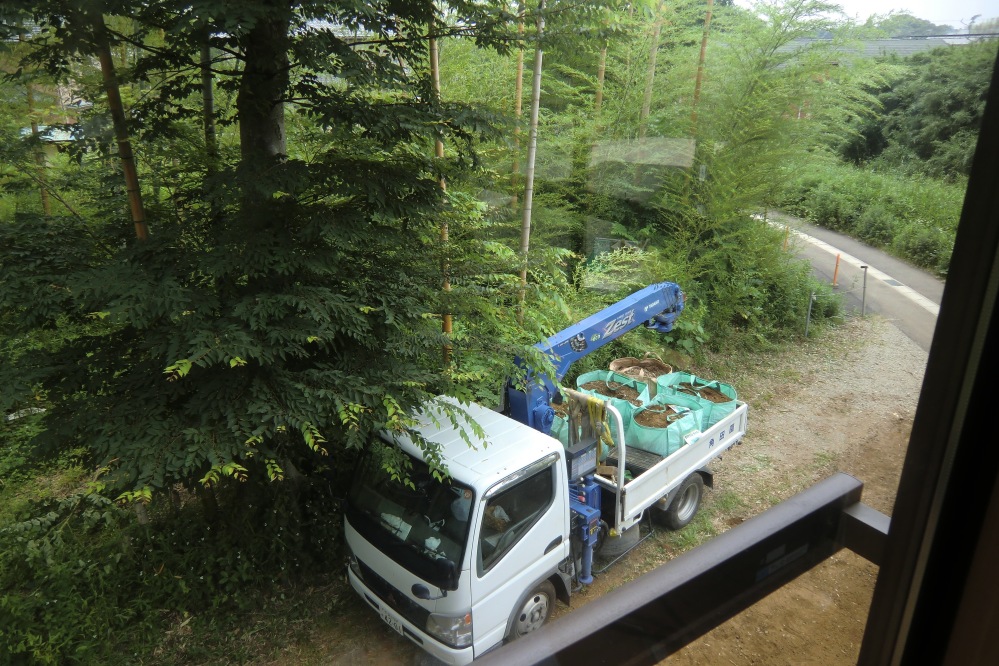 The first order of business was moving the huge mound of dirt displaced by the septic tank. An older man did that and it wasn’t until the second day or so that we realized he was the father of the huge guy in charge of the project. It turned out to be a fairly tedious task. Since carting the dirt away would have cost us more money we asked if he could distribute it evenly along the akamichi–the strip of city-owned dirt road that bordered the southeast side of our property. We didn’t bother asking for permission from the city since it was obvious no public vehicle was ever going to use it. The old guy did as we asked for no extra fee, though to us it looked like extra work, since after depositing the dirt on the road he had to spread it around. In the end he did quite a good job of making it look inconspicuous–except that at the far end of the dirt road, just after it reached past the end of our property, there was a noticeable dip.
The first order of business was moving the huge mound of dirt displaced by the septic tank. An older man did that and it wasn’t until the second day or so that we realized he was the father of the huge guy in charge of the project. It turned out to be a fairly tedious task. Since carting the dirt away would have cost us more money we asked if he could distribute it evenly along the akamichi–the strip of city-owned dirt road that bordered the southeast side of our property. We didn’t bother asking for permission from the city since it was obvious no public vehicle was ever going to use it. The old guy did as we asked for no extra fee, though to us it looked like extra work, since after depositing the dirt on the road he had to spread it around. In the end he did quite a good job of making it look inconspicuous–except that at the far end of the dirt road, just after it reached past the end of our property, there was a noticeable dip.
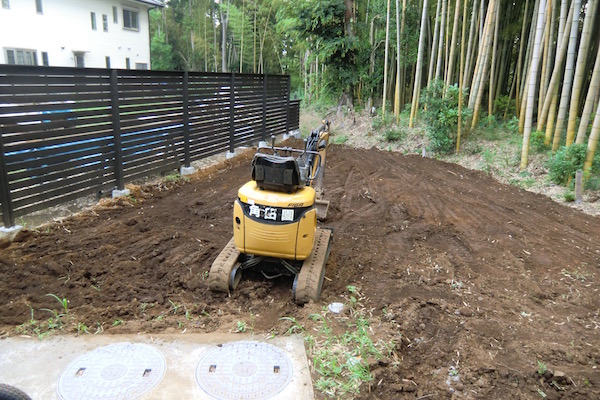 While he did this his son and two employees, one of whom was the son’s brother-in-law, built the kaden–the garden in the front of the house. The border of the garden were defined by large, brown sedimentary rocks that he arranged in a kind of collapsed elliptical pattern along the edge of the main street. Within the ellipse he stuck a few railroad ties lengthwise into the ground at various random positions for “accent.” He then planted two medium sized olive trees and one juneberry tree. When these grew a bit more they would provide a kind of screen in front of the large sliding doors on the south side that faced the street. He also planted smaller plants and shrubs to fill in some of the empty spaces and we could, at our leisure, add whatever we wanted later. It was pretty impressive.
While he did this his son and two employees, one of whom was the son’s brother-in-law, built the kaden–the garden in the front of the house. The border of the garden were defined by large, brown sedimentary rocks that he arranged in a kind of collapsed elliptical pattern along the edge of the main street. Within the ellipse he stuck a few railroad ties lengthwise into the ground at various random positions for “accent.” He then planted two medium sized olive trees and one juneberry tree. When these grew a bit more they would provide a kind of screen in front of the large sliding doors on the south side that faced the street. He also planted smaller plants and shrubs to fill in some of the empty spaces and we could, at our leisure, add whatever we wanted later. It was pretty impressive.
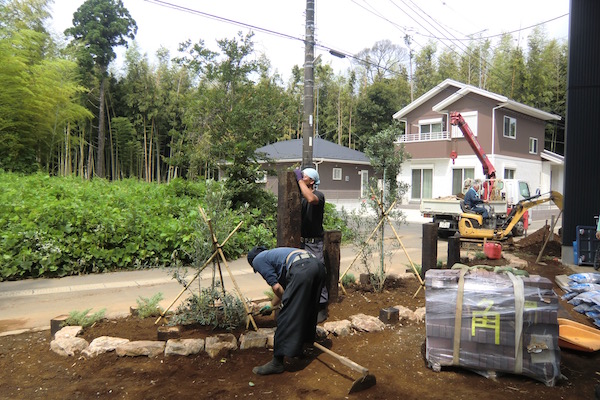
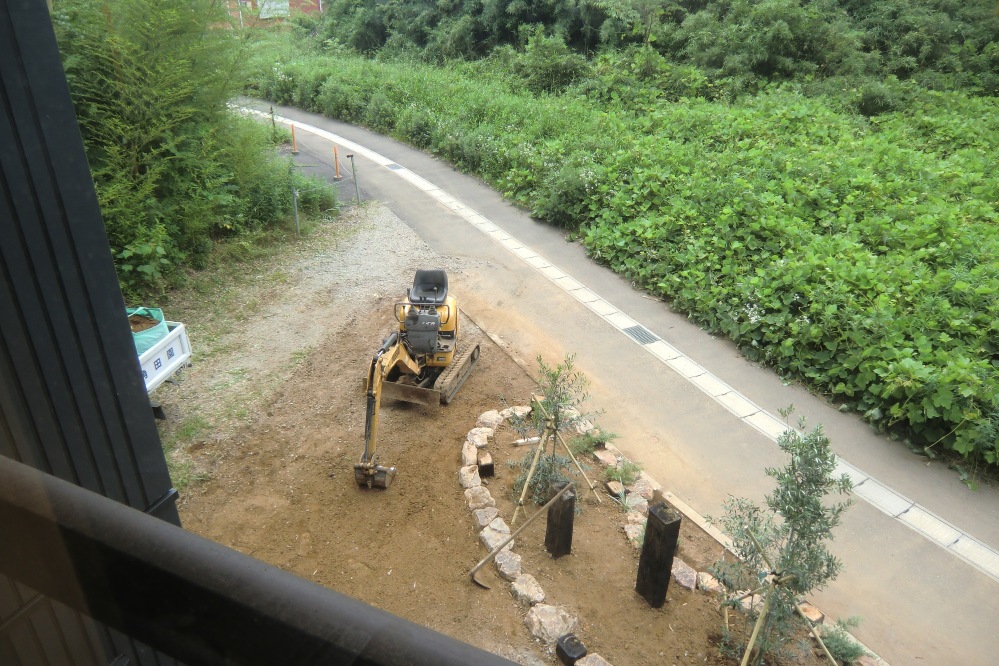

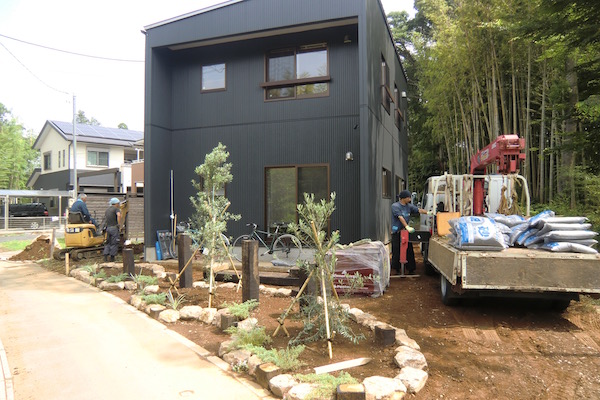 Next was the brick approach to the front door. As with the kaden, we trusted the foreman to use his own judgment in deciding the angle and how much of a spread the approach would take as it progressed from the front stoop to the edge of the street. The difficulty was that there was an uneven downward grade as the property extended to the street, which made leveling the ground more of a chore. After the ground was leveled as much as it could be, he and his crew spread river sand and pounded it in. They then started laying the bricks in a widening pattern that required some of them be cut using power tools so that they could fit. It was fascinating to watch because they didn’t use drawings but simply their eyes to make sure the approach looked balanced and natural. Then they filled the spaces between the bricks with more sand.
Next was the brick approach to the front door. As with the kaden, we trusted the foreman to use his own judgment in deciding the angle and how much of a spread the approach would take as it progressed from the front stoop to the edge of the street. The difficulty was that there was an uneven downward grade as the property extended to the street, which made leveling the ground more of a chore. After the ground was leveled as much as it could be, he and his crew spread river sand and pounded it in. They then started laying the bricks in a widening pattern that required some of them be cut using power tools so that they could fit. It was fascinating to watch because they didn’t use drawings but simply their eyes to make sure the approach looked balanced and natural. Then they filled the spaces between the bricks with more sand.
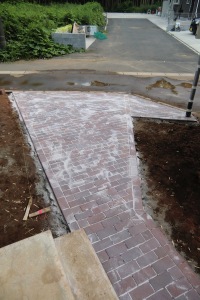

As this was being done, we hired YKK through A-1 to erect a bicycle port against our neighbor’s fence on the north side of the property, opposite the front entrance. Since it took two days, owing to the concrete bases for the supports, the landscapers had to wait. Once the concrete was dry and the lean-to structure was put up, they lay vinyl sheets and then heavy, concrete tetrapod-like blocks under the bicycle port. After the blocks were set, they distributed pink gravel in among the interstices.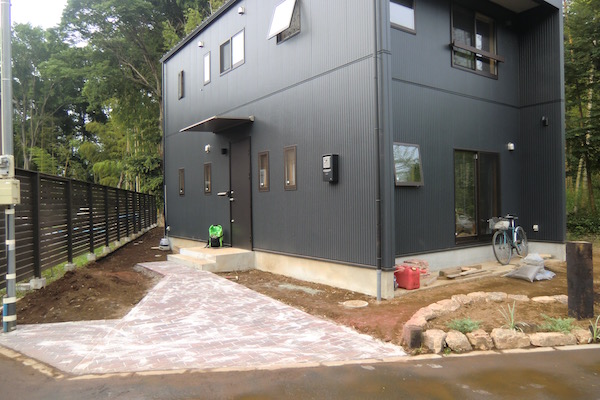
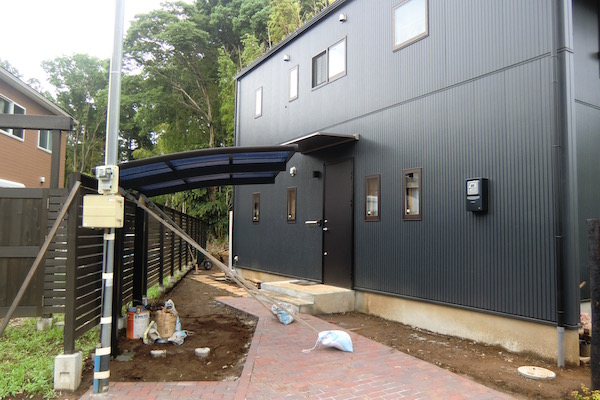
 Then they started working on the border of gravel around three sides of the house. Again they had to pound the ground to make it level, and then covered it with thin vinyl sheeting to prevent plants from growing. Then they covered that with grey gravel. In the back, this belt of gravel was supplemented with long rectangular slabs of yellow slate, which formed a kind of platform between the belt and the grass to come. On the east side of the house the gravel belt was punctuated by squares of the same yellow slate affixed to the ground at step-sized intervals with mortar.
Then they started working on the border of gravel around three sides of the house. Again they had to pound the ground to make it level, and then covered it with thin vinyl sheeting to prevent plants from growing. Then they covered that with grey gravel. In the back, this belt of gravel was supplemented with long rectangular slabs of yellow slate, which formed a kind of platform between the belt and the grass to come. On the east side of the house the gravel belt was punctuated by squares of the same yellow slate affixed to the ground at step-sized intervals with mortar.
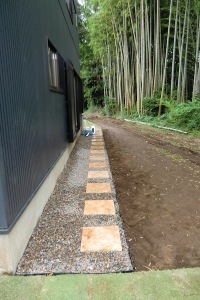
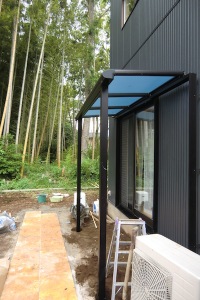 The sod was a major task because prior to laying out the squares of grass they had to flatten the ground as much as possible and then add some extra topsoil. Since our land is unusually shaped and the kaden very curvy, they had to do a lot of cutting of the sod to make it fit, and it was obvious that some of what we paid for was wasted, but in the end sod turns out to be pretty cheap. It was one of the least expensive components of the landscaping job, despite the fact that it took up so much area. In the backyard they left a small triangle of land in the northwest corner unsodded because we though we might want to plant a vegetable garden there, and in the middle of the backyard they planted a Japanese maple and lay the sod around it.
The sod was a major task because prior to laying out the squares of grass they had to flatten the ground as much as possible and then add some extra topsoil. Since our land is unusually shaped and the kaden very curvy, they had to do a lot of cutting of the sod to make it fit, and it was obvious that some of what we paid for was wasted, but in the end sod turns out to be pretty cheap. It was one of the least expensive components of the landscaping job, despite the fact that it took up so much area. In the backyard they left a small triangle of land in the northwest corner unsodded because we though we might want to plant a vegetable garden there, and in the middle of the backyard they planted a Japanese maple and lay the sod around it.
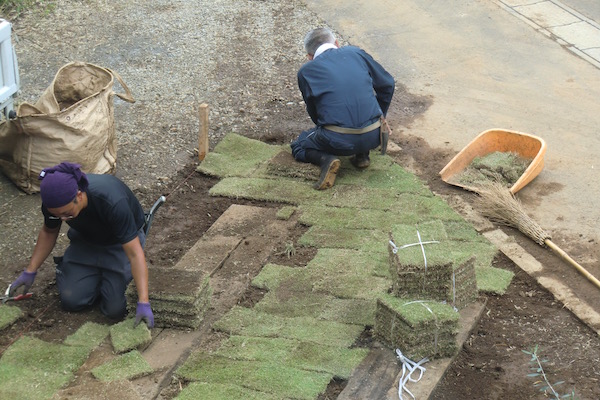
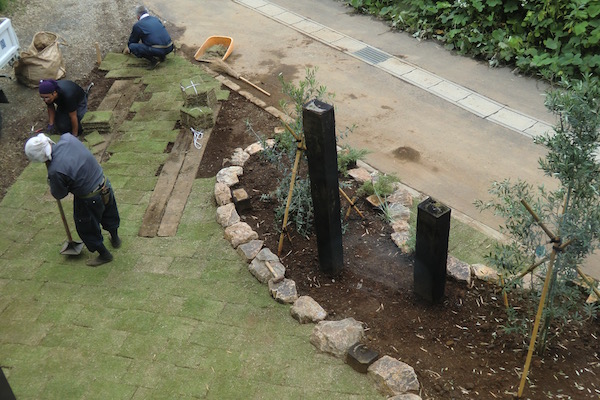
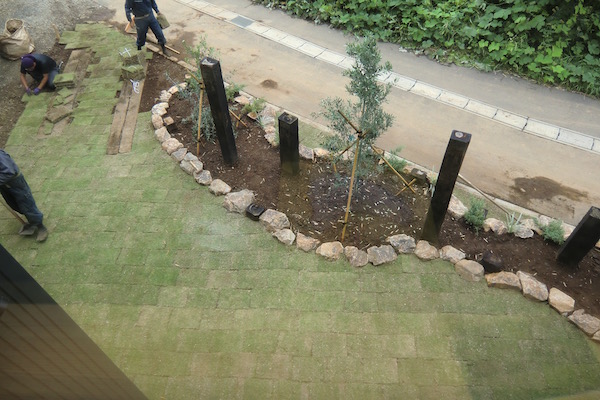
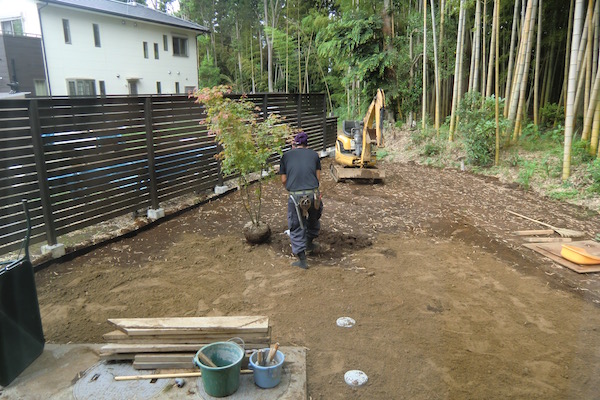
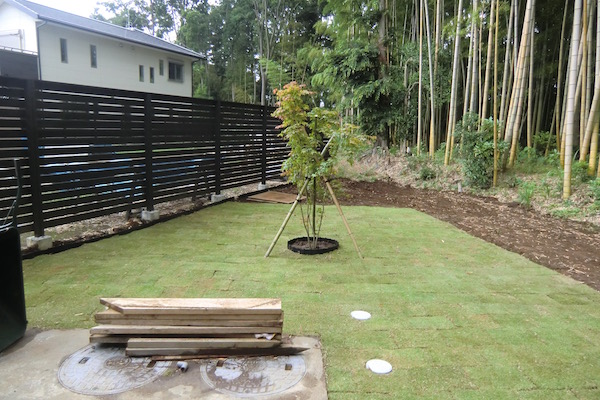 Since we didn’t have a car but thought we should have a parking space, we suggested two railroad ties embedded in parallel in the southeast corner of the property off the main street. The foreman said no problem and we assumed he’d know how far apart the two ties should be and the best way to orient them. After all, he’d done an excellent job designing the kaden without much input from us. However, the day he installed the ties we were out and when we returned we were slightly perplexed to see that he had placed the ends of the two pieces of wood equally distant from the street, but since they were at an angle that was parallel to the hypotenuse of our property’s triangular lot they were staggered in relation to each other; meaning, if a car parked on them the wheels on one side or the other would extend beyond the end of one of the ties; that is, unless the car was really, really small. Since the work was already done and we didn’t have a car anyway, we didn’t ask him to correct the misunderstanding. But for what it’s worth, it was a pretty impressive job.
Since we didn’t have a car but thought we should have a parking space, we suggested two railroad ties embedded in parallel in the southeast corner of the property off the main street. The foreman said no problem and we assumed he’d know how far apart the two ties should be and the best way to orient them. After all, he’d done an excellent job designing the kaden without much input from us. However, the day he installed the ties we were out and when we returned we were slightly perplexed to see that he had placed the ends of the two pieces of wood equally distant from the street, but since they were at an angle that was parallel to the hypotenuse of our property’s triangular lot they were staggered in relation to each other; meaning, if a car parked on them the wheels on one side or the other would extend beyond the end of one of the ties; that is, unless the car was really, really small. Since the work was already done and we didn’t have a car anyway, we didn’t ask him to correct the misunderstanding. But for what it’s worth, it was a pretty impressive job.
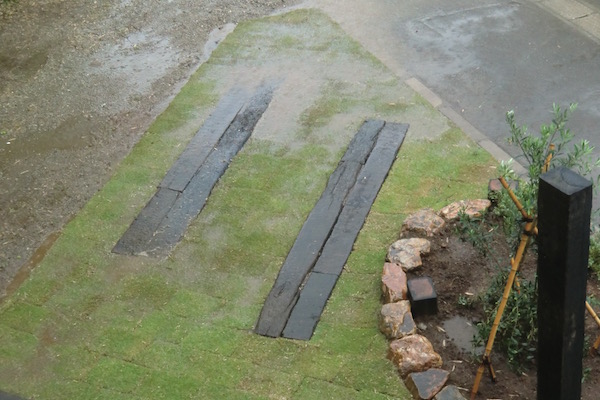 While they were doing this, the same guys from YKK installed sliding storm shutters on four sets of first floor windows as well as an eave-like “terrace” structure in front of the bedroom sliding doors. The storm shutters have louvers that can be adjusted to let in or keep out light when they’re closed, and they came in handy in the winter. We would close them at night and thus were able to keep more heat in the building, but the louvers also did a good job of cutting the sunlight in the summer when it got intense, keeping the house a little cooler. The house has no roof eaves except to the south, and thus the bottom floor gets excess sunlight, which, as we eventually found out, was important for heating the house in the winter, but in the summer was murder unless you closed the blinds. The terrace structure had translucent panels that filtered some of the sunlight without actually getting rid of it, but since we didn’t get any sunlight on that side of the house it didn’t really make a difference. The purpose was mainly to make the house look less boxy. Months later, we would hire a different company to erect a terrace in front of the sliding doors of the office, on the southside, which was much more practical and, we thought, of better quality. The same company also added an extra lean-to structure to the bicycle port since we realized we needed more shelter for things other than bicycles on that side of the house. But that would be later.
While they were doing this, the same guys from YKK installed sliding storm shutters on four sets of first floor windows as well as an eave-like “terrace” structure in front of the bedroom sliding doors. The storm shutters have louvers that can be adjusted to let in or keep out light when they’re closed, and they came in handy in the winter. We would close them at night and thus were able to keep more heat in the building, but the louvers also did a good job of cutting the sunlight in the summer when it got intense, keeping the house a little cooler. The house has no roof eaves except to the south, and thus the bottom floor gets excess sunlight, which, as we eventually found out, was important for heating the house in the winter, but in the summer was murder unless you closed the blinds. The terrace structure had translucent panels that filtered some of the sunlight without actually getting rid of it, but since we didn’t get any sunlight on that side of the house it didn’t really make a difference. The purpose was mainly to make the house look less boxy. Months later, we would hire a different company to erect a terrace in front of the sliding doors of the office, on the southside, which was much more practical and, we thought, of better quality. The same company also added an extra lean-to structure to the bicycle port since we realized we needed more shelter for things other than bicycles on that side of the house. But that would be later.
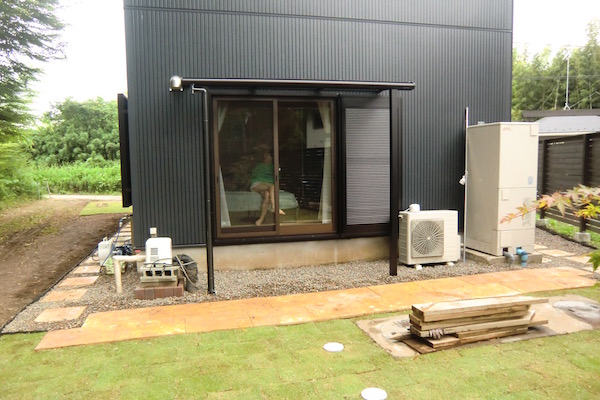
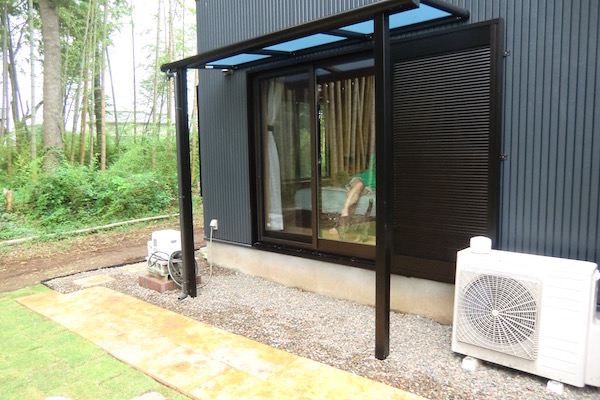 There was still a lot of stuff we wanted to do, but at least now the mud problem had been tamed somewhat. A few months later, when the A-1 architect who worked on our house came to talk about something, he commented that none of the company’s clients had done as much work on landscaping as we had, a reflection on A-1’s clientele, perhaps, since most tend to hire the company because of their relatively low prices. Likely, they’re not going to have as much money for extras like landscaping. But it’s also a reflection of the housing market in general. Developers usually throw in landscaping with the house, and A-1’s suggestions tend toward those that use a lot of concrete. In any case, it was starting to look more like a proper place to live out the rest of your life.
There was still a lot of stuff we wanted to do, but at least now the mud problem had been tamed somewhat. A few months later, when the A-1 architect who worked on our house came to talk about something, he commented that none of the company’s clients had done as much work on landscaping as we had, a reflection on A-1’s clientele, perhaps, since most tend to hire the company because of their relatively low prices. Likely, they’re not going to have as much money for extras like landscaping. But it’s also a reflection of the housing market in general. Developers usually throw in landscaping with the house, and A-1’s suggestions tend toward those that use a lot of concrete. In any case, it was starting to look more like a proper place to live out the rest of your life.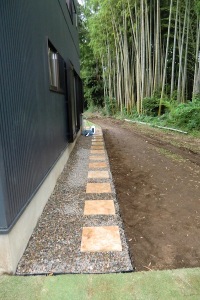
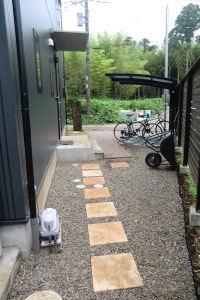
Wow, looks great! When those trees grow, it will be even better. For ground cover in the kaden, you might consider different sedums and creeping thyme. Or buy flats of different kinds of moss on Amazon and tuck it here and there. The stuff that survives looks pretty good.
In Tokyo people don’t do landscaping because, more and more, there is no space around the tightly packed houses to do it. Although there is usually a 50 or maybe 60 percent kenpeiritsu, a lot of that is a poured car park or edges of the house that have drainage pipes shallowly buried, so there’s not much you can do.
Also, the typical home buyer will save just enough to pay the down payment on the loan, which buys the land and the structure. But you really need about twice that much, in ready cash, with the rest going to furniture, appliances, window treatments, and of course exterior/landscaping stuff. Once the house is bought and a couple of years have passed, owners get cheap and don’t want to spend the money, so they end up trying to do it themselves from the home center, which is not quite the same. As you mentioned, ground leveling, compaction under walkways, drainage, and so on, are beyond what you can easily do yourself.
I think that a less expensive house with great landscaping is much better than blowing all the money on the house and leaving the exterior bare or fully concreted.
LikeLike
I agree with your sentiment to some degree as I think the cheap plastic siding many use here looks nasty and needs replacing every 15 years or so, so isn’t that cheap anyway in the long term!
However, much depends on personal circumstances. If you live in Kanto then it might be easier to build a house with thinner walls and less insulation and so reducing the costs. But if you live in Tohoku or Hokkaido you’re going to want a house with thick walls that keep the cold out in winter!
Also, if you have children then the size of the house is obviously going to be important because you don’t want it to be too cramped!
What annoys me is that, whilst land is expensive here due to it being 70% mountains, there’s a lot of land available for building that has abandoned houses on it that can’t be touched (for ever?). It keeps land prices artificially high and means more people forgo nice things like decent house exterior and gardens.
LikeLike
Spent the day reading up about your house and have enjoyed your stories. I’m in the middle of the process now and am coming up against some issues that you have experienced. Regarding your septic tank, what kind of costs do you average per year? How is it taking care of it, any downsides? How about smells?
Also, with your well, any issues regarding the water? Has the quality changed at all?
LikeLike
We’ve had no problems with the septic tank, though we’ve heard from one neighbor that she’s had problems with hers, but it seems to have more to do with drainage in the neighborhood than with the tank itself. Though we’re on a hill, the storm drains sometimes get backed up when it rains really hard, and I guess that causes some problems with her tank. We’ve had none. Our tank’s capacity is for a house with five residents, and there’s only two of us (plus 3 cats), so it shouldn’t be a problem. As for costs, we pay about ¥5,000 a year to the local government for inspections, which are mandatory and take place every other month. If they find something wrong or if the tank needs cleaning, we would pay for that but so far everything is OK. No odor problems at all.
The well water has a lot of minerals and does have a slight odor but no taste. We don’t use it for drinking or cooking. There are two supermarkets near our home that give away free filtered water, so we just go there every day and fill up our jugs. It doesn’t seem to affect the laundry situation, but the shower head has to be taken apart and cleaned every few weeks because particles build up in the holes.
LikeLike
Thanks for the reply. It’s very helpful. One more question regarding the land itself. After you purchased it was there any other surveying done ? Or was all that completed before hand?
LikeLike
Very late to make a comment here but…
I’ve read up on your home building process and it’s really fascinating. I’ve checked out A-1 and really like their designs and especially the relatively low costs involved. I may have missed this in a post somewhere, but were you satisfied with them through the entire process? Would you choose them again or recommend them to a friend?
Thanks!
-Matt
LikeLike
I don’t think we can say we were completely satisfied with them throughout the process. For one thing, the payment system of a third before they start, a third when the roof goes up, and then a third upon completion was a bit difficult because of the timing of our loan, which was very small, but still… Nevertheless, that was essentially an administrative thing. As far as the building went, it was slower than other home builders. They started in September and didn’t finish until the end of January. That was fine with us, but most builders take no more than three months these days. The reason has to do with the fact that A-1 finds local carpenters to do the building, and sometimes there’s a labor crunch in the area. On most days there was only one person working on our house. And we’re not totally satisfied with the finished product, but that had more to do with us than with A-1. Our priority was always keeping the cost down below a certain threshold, but now we wish we had spent more money on things like the exterior and bathroom fixtures. The stairway had some cosmetic problems, but when we pointed it out to A-1 two years later they sent a carpenter over and fixed it for free. The bottom line is, A-1 prices are reasonable, but you do get what you pay for. They’re mainly a design company, meaning that’s where they derive their profits. All their materials are bought in bulk so there are limitations in that regard. They didn’t make much money off of us because our design was very, very simple. But they didn’t pressure us. The salesman and the architect were always honest with us, but it was obvious we weren’t the ideal customer.
LikeLike
Fantastic reply. Thank you very much. I’m debating going through A-1 vs. directly hiring a local carpenter/builder. Great food for thought.
LikeLike